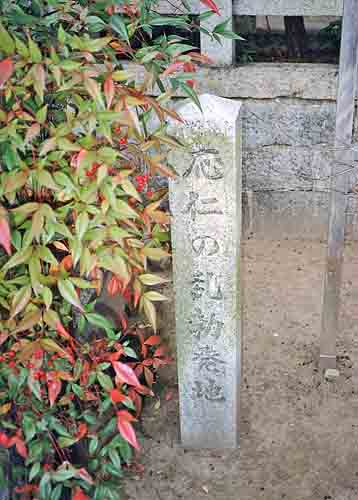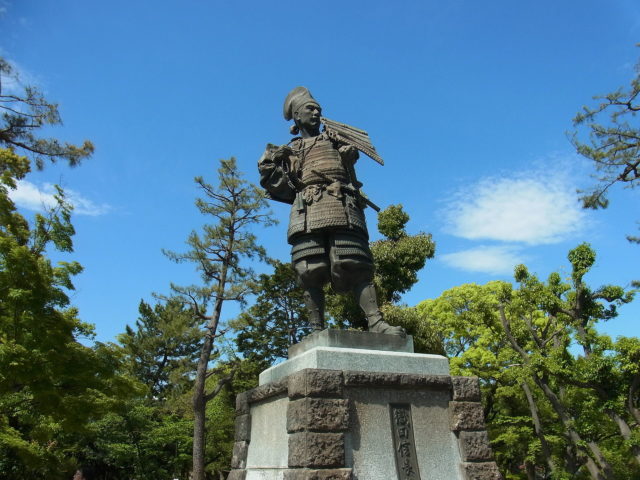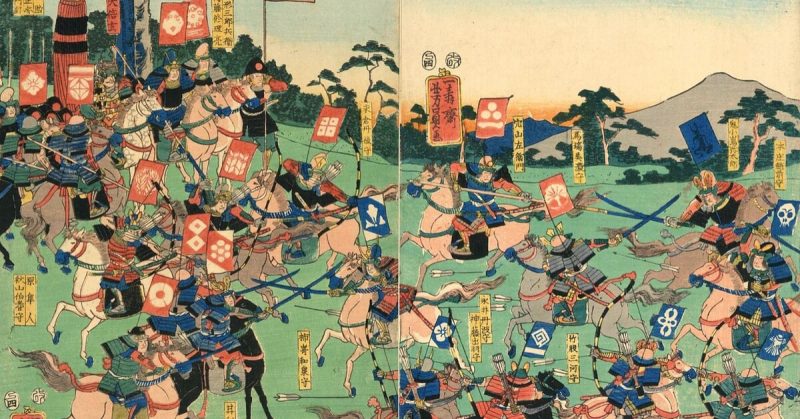From 1467 to 1603, Japan suffered through one of the most painful and tumultuous periods in its history. Central authority collapsed. The nation was divided between feuding warlords. It was the Sengoku-Jidai: the Age of the Country at War.
The Onin War
In 1467, a decade-long conflict broke out. The Onin War began as a dispute over who would inherit the position of shogun – the military dictator who ruled Japan on behalf of the figurehead Emperor. A rival imperial court was brought back from destruction as lords fought for control of the country. The Akamatsu, Yamana and Hosokawa clans were particularly prominent, but they dragged the rest of the aristocracy into their conflict.
Beginning in Kyoto, the war brought terrible destruction to Japan’s capital city. Over the course of the war, there was seldom time for the city’s inhabitants to rebuild the charred ruins of homes destroyed in the fighting.
By the end of the war, there was nothing worth fighting over. Local lords had become powerful and the Shogun weak. It did not matter who held the title. The country lay shattered.
After Onin
The credibility of the samurai elite and the lords who led them had been severely damaged. Unable to trust in them for security, people looked to themselves for protection.

One symptom of it was a rise in the Ikki; leagues of armed peasants. They were as resentful of the merchants and pawnbrokers who had profited at their expense as they were of the powerful samurai elite. They took up arms, starting out as nothing more than rioting mobs, and became organizations for local protection and self-determination.
Kyoto saw the rise of a similar movement, but with a very different perspective. Resentful of the damage the samurai had done them, fearful of the peasant bands roaming the fields, the urban population formed their own armies inspired by a martial form of Buddhism. The capital was no longer under the government’s control.
The Ikko-Ikki
The most powerful of those peasant movements was the Ikko-Ikki or Single-Minded League. Jodo-Shinshu Buddhists, they believed that to retreat in battle meant eternal damnation while death in combat led to heaven. Initially egalitarian, they took oaths of loyalty while standing in a circle so that all were equal in position.
By 1528, the Ikko-Ikki had become powerful enough to launch a hard fought but failed attempt to seize control of Kyoto. Their greatest success lay in the north, where they controlled the province of Kaga from 1488 to 1580.
The West
Across Japan, violent feuds and Machiavellian schemes were played out.
In the west, the Ouchi clan fell after nearly a thousand years. Theirs had been a turbulent history, sometimes backing the wrong side in Japan’s various crises. Early in the Sengoku period, they reached the peak of their power. Ouchi Yoshioki restored a Shogun and sent opposing armies packing.
His son was much weaker and less warlike. Betrayed by one of his own vassals, he committed suicide while under siege. He was avenged by another of his vassals, Mori Motonari, leading the Mori clan to take the Ouchi’s place of power.
The East
In the east, a four-way struggle took place between the Uesugi, Takeda, Hojo, and Imagawa clans.
Decades of conflict tore the region apart as those clans vied for power. War, diplomacy, marriage, and assassination all played their part. There was seldom a clear leader in their struggles, and no-one could gain full domination. The Hojo, with their strong military organization, lasted the longest. However, even they were eventually brought low by a new force emerging from the chaos of war.

Nobunaga
In 1560, a young upstart named Oda Nobunaga attacked an Imagawa army at Okehazuma gorge. Despite being outnumbered twelve to one, he smashed them in only 15 minutes, ending the power of the Imagawa.
Nobunaga was an incredibly gifted commander. With an ever-growing army, he set out to conquer the provinces of Japan. His boldness, ingenuity, and willingness to embrace new ways of fighting saw him overcome traditional armies.
In 1575, he destroyed the charging samurai of the Takeda clan with a fortified line of arquebusiers at Nagashino.
In 1580, the last Ikko-Ikki stronghold surrendered to him.
In 1582, disaster struck. One of Nobunaga’s generals betrayed and ambushed him. Under attack in a burning temple, Nobunaga committed suicide.
Hideyoshi
Nobunaga was succeeded by Hideyoshi, one of his greatest lieutenants. A peasant who had risen to power through his skill as a warrior, Hideyoshi is sometimes called the Napoleon of Japan.
During a power struggle following Nobunaga’s death, Hideyoshi quickly defeated his rivals and avenged his master. One by one, he brought the other lords into line by force of arms.
Then he set about consolidating his power. He destroyed the fortresses of other lords and built stronger ones under his control. In 1587, he disarmed the peasantry, melting down their weapons to make parts for a statue of the Buddha. In 1590, he brought the Hojo to heel following a protracted siege.
His uniquely successful reign ended on a note of failure. One attempt to conquer Korea failed, and another was abandoned following his death.
Tokugawa
One final period of war followed Hideyoshi’s death. Again, the demise of a forceful ruler was followed by a fight for control of his legacy.
The one who emerged triumphantly was Tokugawa Ieyasu. A lifelong samurai, he had survived a musket ball striking his armor earlier in life. He was a cunning tactician. By threatening his enemies lines of communication, he drew them into a fight on ground of his choosing at Sekigahara in 1600. It was one of the last field battles between samurai.
Ieyasu emerged victorious, becoming Shogun.
The Sengoku-Jidai was effectively at an end. Tokugawa faced one last great battle at Osaka in 1615, but his control of the nation was never again seriously threatened.
After 100 years of warfare, the Shogun clan emerged that ran Japan through centuries of peace and progress.
Source:
Stephen Turnbull (1987), Samurai Warriors
